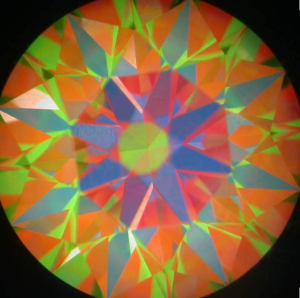Previously on the Adiamor blog, we spent some time breaking down the ASET image as a tool. However, one important topic we did not cover is how to read and use ASET images as a consumer. Although ASET images contain sophisticated information, they are relatively simple to understand. To help our customers make the best possible decisions when buying diamonds online, we will explain how to view ASET images and parse out the diamond specifications they include.
The Meaning of ASET Image Colors
When viewing an ASET image, one of the first things you will notice is there are three main colors: red, green, and blue. The red color represents the brightest light return in a diamond from a direct light source while green demonstrates light return from an indirect light source. This means the red and green colors demonstrate a diamond’s fire and brilliance. The most telling part of an ASET image, though, is provided by the blue colors. Blue is showing the diamond’s internal patterns, and therefore explains the quality of the diamond’s cut. A higher quality diamond cut will provide symmetrical blue coloring. On the other hand, diamonds with poor cut quality will have clustered areas of blue.
The Best Diamonds Have Symmetrical ASET Images
The easiest way to understand a diamond’s quality by viewing an ASET image is examine the symmetry. Take the above round cut diamond as an example; it is an excellent quality diamond. The more symmetrical the coloring, the higher quality the diamond’s cut. This is because diamonds with ideal proportions will return more light. Therefore, diamonds that return more light and have more sparkle will be more symmetrical. However, because a diamond’s cut is not the only way to measure a diamond’s quality, it is only one part of the equation. Although ASET images are helpful, they are not the only tool for deciding which diamond to purchase. Before buying a diamond, all of the four c’s must be considered.

